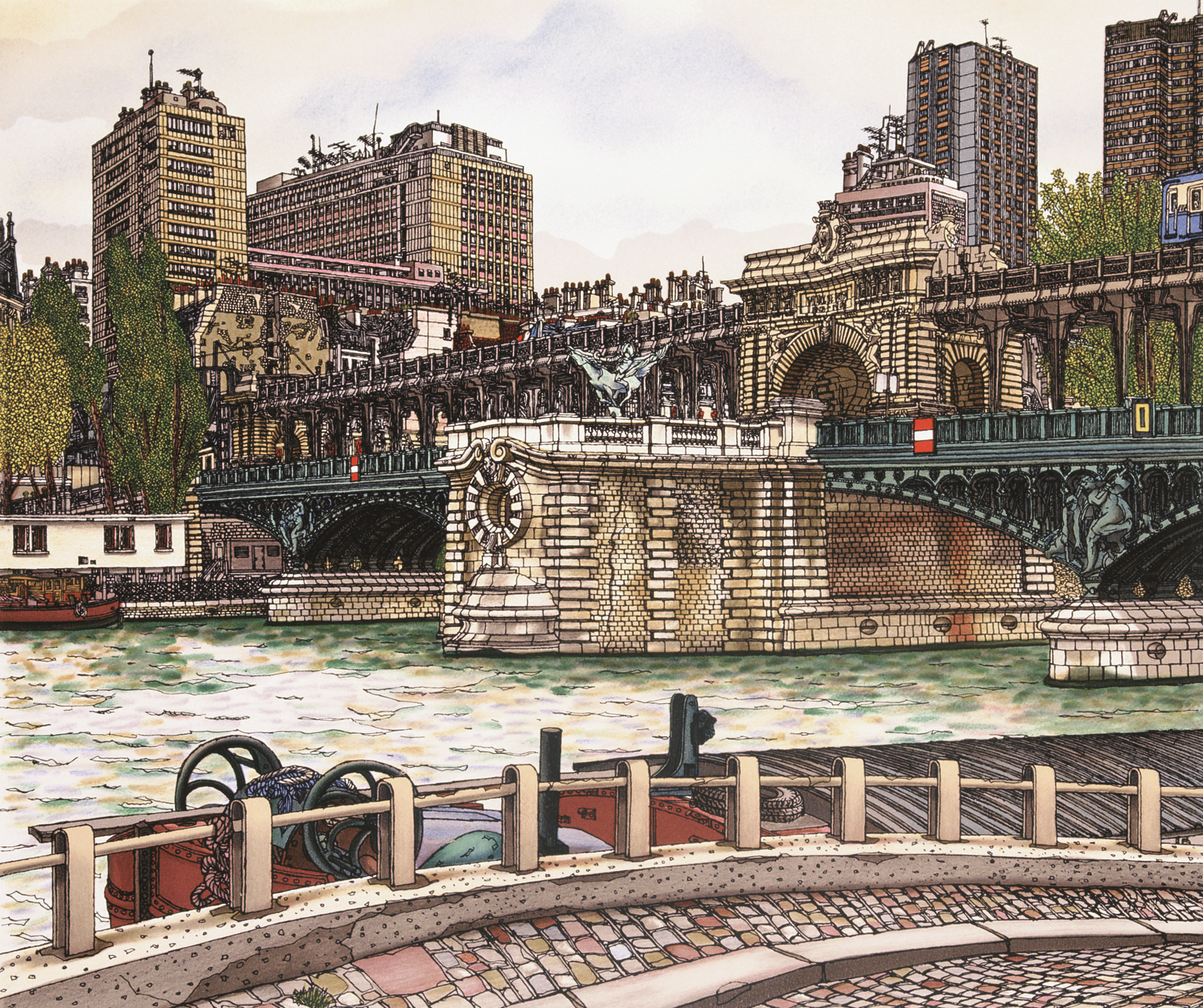Le pont de Bir-Hakeim / The pont de Bir-Hakeim / ビラッケムの橋
Dublin Core
Title
Le pont de Bir-Hakeim / The pont de Bir-Hakeim / ビラッケムの橋
Subject
Lithographie, Pont
Description
Appelé autrefois Pont de Passy, il devient, le 18 juin 1949, Pont de Bir-Hakeim afin de commémorer la victoire en juin 1942 d’une bataille acharnée qui a duré deux semaines dans le désert de Libye. Les forces françaises libres ont aidé l’armée anglaise à combattre les chars du corps d’armée de la coalition italo-germanique. C’est un événement important qui a permis aux Forces Françaises Libres du Général de Gaule de se faire reconnaître. La même année, le 16 juillet, 30 000 juifs sont rassemblés par l’armée allemande occupant Paris dans un bâtiment sur la rive droite de ce pont. Ce bâtiment n’existe plus. Ce jour-là fut celui du premier convoi vers les camps de concentration en Allemagne. A la sortie du métro, une stèle a été érigée pour commémorer cette date. En allant vers la droite, on voit la Maison de la culture du Japon à Paris, inaugurée le 30 mai 1997. C’est un lieu familier pour les Japonais dans ce périmètre historiquement riche. Quand je suis arrivé à Paris, d’ici jusqu’au sud, le quartier était occupé par les usines Citroën et d’autres constructeurs automobiles. Après leur déménagement en grande banlieue, les terrains vides sont devenus un ensemble immobilier résidentiel nommé Front de Seine. On l’aperçoit le long de la Seine. Inauguré en 1906, le pont de Bir-Hakeim est un bel exemple de design industriel du début du 20e siècle. La partie haute sert de voie pour le métro de Paris. Sous le pont, une voie pour les voitures et une autre réservée aux piétons. Les lieux, souvent utilisés comme décors de films, sont inscrit aux Monuments Historiques depuis 1986.
This used to be called the Pont de Passy in the past, but the name was changed to the Pont de Bir-Hakeim on June 18th, 1949. The British Armed Forces was struggling against General
Rommel’s tank army from the axis of Germany and Italy, fighting fierce battles for two weeks in the Libyan Desert in June 1942. Then the French Free Corps hurried there to assist them the victory. The name was changed to commemorate this. That was a very important event because General de Gaulle’s French Free Corps, which was barely recognised until then, was acknowledged. On July 16th of the same year, 30,000 Parisian Jews were gathered by the occupying German army into the winter cycling stadium, which was located at the right side of the bridge, to be sent out to concentration camps in Germany. The building is no longer there. A memorial stands across the exit of subway still today. On the left side of the bridge, the Japan Cultural Institute opened on May 31st 1997. This is a place extremely familiar to Japanese people but this history hangs over the area. When I came to Paris, south of here the walls of the Citroën car factory and the buildings which developed in around it from 1916 filled the area. All the factories moved to the suburbs in 1976 and the housing complex Front de Seine began to develop in the space vacated by them.The two-storey bridge opened in 1906 with railway above and the roadway and pavement beneath. This is a beautiful bridge, typifying industrial design of the early 20th century. This is also often used in films and was designated a historical building in 1986.
Rommel’s tank army from the axis of Germany and Italy, fighting fierce battles for two weeks in the Libyan Desert in June 1942. Then the French Free Corps hurried there to assist them the victory. The name was changed to commemorate this. That was a very important event because General de Gaulle’s French Free Corps, which was barely recognised until then, was acknowledged. On July 16th of the same year, 30,000 Parisian Jews were gathered by the occupying German army into the winter cycling stadium, which was located at the right side of the bridge, to be sent out to concentration camps in Germany. The building is no longer there. A memorial stands across the exit of subway still today. On the left side of the bridge, the Japan Cultural Institute opened on May 31st 1997. This is a place extremely familiar to Japanese people but this history hangs over the area. When I came to Paris, south of here the walls of the Citroën car factory and the buildings which developed in around it from 1916 filled the area. All the factories moved to the suburbs in 1976 and the housing complex Front de Seine began to develop in the space vacated by them.The two-storey bridge opened in 1906 with railway above and the roadway and pavement beneath. This is a beautiful bridge, typifying industrial design of the early 20th century. This is also often used in films and was designated a historical building in 1986.
昔はパッシー橋と呼んでいたのだが、一九四九年六月十八日からビラッケム橋と名前が変った。一九四二年六月にリビヤ砂漠で二週間の激戦、ドイツとイタリア連合のロンメル将軍の戦車軍団にたいして苦戦していた英国軍の応援に、フランス自由軍団が駆けつけて勝利となったのを記念して、この名前に変わったのである。それまであまり問題にされていなかったドゴール将軍のフランス自由軍団の、存在を認めさせることになった重要な出来事だったのである。同じ年の翌月、七月十六日、この橋の右袂にあった、今は無い建物、冬の競輪場構内に、パリ占領ドイツ軍によって、市内のユダヤ人三万人が集められて、初めてドイツの収容所に送り出された記憶が残り、今も地下鉄の出口の向かいに記念碑が立てられている。橋の左手の袂には、一九九七年五月三一日にパリ日本文化会館がオープン、日本人にも馴染みが深い場所だが、歴史の重みは濃いのである。私のパリに来た頃は、ここから南はズーッと一九一六年にスタートした、シトロエンの自動車工場と、次々発展したその関連の建物で、その塀ばかりが占めていた。一九七六年工場が全部郊外に移転して、空き地に現在の河沿いのビル群、フロン・ド・セーヌ団地が立ち並び始めたのだった。橋は一九〇六年に開通したもので、上を地下鉄の高架橋が走り、下が歩道と車道の、二〇世紀初頭工業デザインの、美しい橋である。映画にもよく使われて、一九八六年から歴史建造物に指定されている。
Creator
Kojiro Akagi (1934-2021)
Date
Juillet 1992, July 1992
Rights
Fonds de dotation Kojiro AKAGI
Format
Lithographie, Atelier Grapholith, 120 tirages + 27 E.A. romain,
sur papier Arches 47,5 x 64,5 cm.
sur papier Arches 47,5 x 64,5 cm.
Type
Lithographie
Tags
Citation
Kojiro Akagi (1934-2021), “Le pont de Bir-Hakeim / The pont de Bir-Hakeim / ビラッケムの橋,” Kojiro Akagi - Fonds de dotation Kojiro AKAGI , accessed October 15, 2025, https://kojiroakagi.com/gallery/items/show/106.

